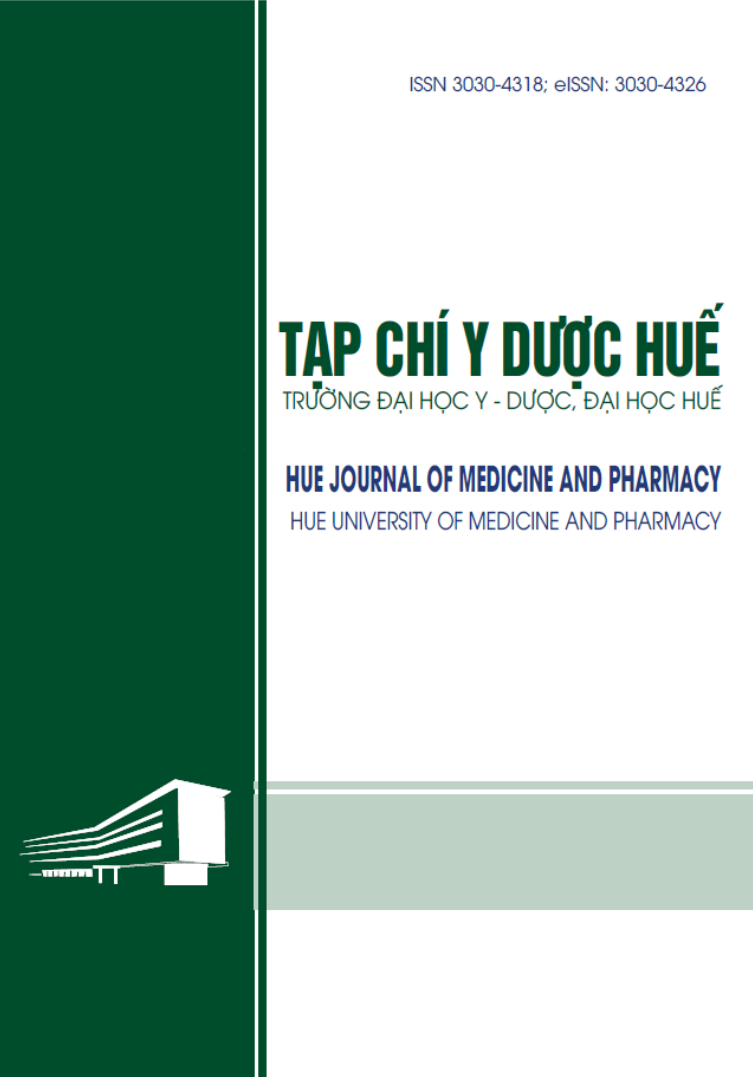Abstract
Background: Onychomycosis is a relatively common dermatological disease. C. albicans is the most common yeast pathogenic in this disease. In addition, non - albicans Candida species and other yeast were also causative agents. Non - albicans Candida species were less susceptible to antifungal drugs than C. albicans.
Objectives: 1. To identify yeast species from onychomycosis by cultured on Candida chromogenic agar and carbohydrate assimilation testing by API 20C test. 2. To evaluate antifungal susceptibility testing of Candida isolates by disk difusion method.
Materials and methods: A cross-sectional survey to descri be 39 patients with onychomycosis examined at the Dematology Clinic - Hue University of Medicine and Pharmacy Hospital and Hue City Dermatology Hospital from 10/2023 to 05/2024.
Results: C. parapsilosis was the dominant species isolated (46%), followed by C. albicans 12%, C. tropicalis 16%, C. guilliermondii 8%, and C. famata 4%. Additionally, Trichosporon asahi and Trichosporon muicoides were isolated. All Candida isolates were susceptible to amphotericin B, nystatin, itraconazole, and clotrimazole. The resistance rate of Candida to fluconazole, voriconazole, ketoconazole, and miconazole were 32.6%, 25.6%, 9.3%, and 27.9%, respectively. C. albicans was susceptible to all drugs checked in this study, except for fluconazole. Azole resistance observed in non - albicans Candida species, in which C. tropicalis had the highest resistance rate. Trichosporon spp. were susceptible to all drug tested, except for ketoconazole.
Conclusion: C. parapsilosis was the most common pathogenic species isolated from onychomycosis patients. Non - albicans Candida species were resistance to azole than C. albicans. C. tropicalis had the highest resistance rate to
azole drugs.
| Published | 2025-06-25 | |
| Fulltext |
|
|
| Language |
|
|
| Issue | Vol. 15 No. 3 (2025) | |
| Section | Original Articles | |
| DOI | 10.34071/jmp.2025.3.7 | |
| Keywords | Candida, nấm men, nấm móng, thử nghiệm độ nhạy cảm, đề kháng Candida, onychomycosis, yeast, antifungal susceptibility testing, resistance |

This work is licensed under a Creative Commons Attribution-NonCommercial-NoDerivatives 4.0 International License.
Copyright (c) 2025 Hue Journal of Medicine and Pharmacy
Kaur R., Kashyap B., Bhalla P., Onychomycosis-epidemiology, diagnosis and management. Indian J Med Microbiol, 2008. 26(2): p. 108-16.
Dhamoon R.K., Popli H., Gupta M., Novel Drug Delivery Strategies for the Treatment of Onychomycosis. Pharm Nanotechnol, 2019. 7(1): p. 24-38.
Thomas J., Jacobson G.A., Narkowicz C.K., Peterson G.M., Burnet H., et al., Toenail onychomycosis: an important global disease burden. J Clin Pharm Ther, 2010. 35(5): p. 497-519.
Gupta A.K., Stec N., Summerbell R.C., Shear N.H., Piguet V., et al., Onychomycosis: a review. J Eur Acad Dermatol Venereol, 2020. 34(9): p. 1972-1990.
Gupta A.K., Versteeg S.G., and Shear N.H., Onychomycosis in the 21st Century: An Update on Diagnosis, Epidemiology, and Treatment. J Cutan Med Surg, 2017. 21(6): p. 525-539.
Guinea J., Global trends in the distribution of Candida species causing candidemia. Clin Microbiol Infect, 2014. 20 Suppl 6: p. 5-10.
Ngô Thị Minh Châu, Nguyễn Thị Hồng Hạnh, Khảo sát đặc điểm nuôi cấy nấm Candida spp. trên môi trường thạch sinh màu và các môi trường sinh bào tử bao dày. Tạp chí Y Dược học - Trường Đại học Y Dược Huế, 2023. 13: tr. 176-184.
Ngô Thị Minh Châu, Tôn Nữ Phương Anh, Đỗ Thị Bích Thảo và cộng sự, Ứng dụng kỹ thuật sinh học phân tử định danh loài một số chủng nấm men và xác định tỷ lệ đề kháng với thuốc kháng nấm bằng phương pháp khuếch tán trên đĩa thạch. Tạp chí Y học thực hành, 2016. 1005: tr. 484-489.
Tabassum H., Adil M., Amin S.S., Mohtashim M., Bansal R., et al., The Impact of Onychopathies on Quality of Life: A Hospital-based, Cross-sectional Study. Indian Dermatol Online J, 2020. 11(2): p. 187-194.
Jha B., Sharma M., Gc S., Sapkota J., Onychomycosis among Clinically Suspected Cases Attending the Dermatology Out-patient Department of a Tertiary Care Centre: A Descriptive Cross-sectional Study. JNMA J Nepal Med Assoc, 2021. 59(237): p. 450-453.
Tôn Nữ Phương Anh, Nghiên cứu bệnh nguyên và một số kỹ thuật chẩn đoán bệnh nấm móng ở một số phường Thành phố Huế, Luận văn Thạc sỹ y học, Trường Đại học Y Dược Huế, 2006.
Borba O.S.M., Ogawa M.M., Kirsztajn G.M., Tomimori J., Onychomycosis in immunocompromised population: Phenotypic and molecular identification. Mycoses, 2023. 66(11): p. 1018-1024.
Pakshir K., Zomorodian K., Zakaei A., Motamedi M., Rahimi Ghiasi M., et al., Molecular identification and in-vitro antifungal susceptibility testing of Candida species isolated from patients with onychomycosis. Curr Med Mycol, 2015. 1(4): p. 26-32.
Feng X., Ling B., Yang X., Liao W., Pan W., et al., Molecular Identification of Candida Species Isolated from Onychomycosis in Shanghai, China. Mycopathologia, 2015. 180(5-6): p. 365-71.
Merad Y., Derrar H., Tabouri S., Berexi-Reguig F., Candida guilliermondii Onychomycosis Involving Fingernails in a Breast Cancer Patient under Docetaxel Chemotherapy. Case Rep Oncol, 2021. 14(3): p. 1530-1535.
Sageerabanoo A.M., Oudeacoumar P., and Udayashankar C., Onychomycosis due to Trichosporon mucoides. Indian Journal of Dermatology, Venereology and Leprology, 2011. 77: p. 76.
Capoor M.R., Agarwal S., Yadav S., Saxena A.K., Ramesh V., et al., Trichosporon mucoides causing onychomycosis in an immunocompetent patient. Int J Dermatol, 2015. 54(6): p. 704-707.
Abu El-Hamd M., Abd Elhameed M.I., Shalaby M.F.M., Saleh R., In vitro antifungal susceptibility testing of fungi in patients with onychomycosis. Dermatol Ther, 2020. 33(3): p. e13429.
Pristov K.E., Ghannoum M.A., Resistance of Candida to azoles and echinocandins worldwide. Clin Microbiol Infect, 2019. 25(7): p. 792-798.
Nguyễn Văn Minh, Định danh và khảo sát mức độ nhạy cảm với thuốc kháng nấm của các loài Candida sp. gây bệnh viêm quanh móng, Luận văn Thạc sỹ Y học, Trường Đại học Y dược Huế, 2017.
Magobo R.E., Lockhart S.R., and Govender N.P., Fluconazole-resistant Candida parapsilosis strains with a Y132F substitution in the ERG11 gene causing invasive infections in a neonatal unit, South Africa. Mycoses, 2020. 63(5): p. 471-477.






